Wild Plants of Massachusetts, Foraging in Spring
As winter makes its final retreat, many foragers in New England head into the forest to gather wild edibles; I joined them and created a foraged lunch with my finds
Spring is a symbol of awakening, renewal and vitality, and that is even more felt in New England, where winters are unforgiving. With the first warming days of April many people get out into the wild, paying attention to what’s around their feet and up on the trees, hunting for native varieties of edible plants, mushrooms and fruits.
After more than a year researching and learning about New England dishes and ingredients, it was time for me to delve into the forest and join the foragers in the hunt. Wild plants are not widely consumed, but they are a testament of what indigenous people foraged and of what the English settlers ate and even planted.
So I got in touch with Diana Burnell, a passionate local forager that organises trips to connect people to nature. My husband Ross, and I joined a group of other 8 people last weekend and headed to Lynn Woods, in Massachusetts, a municipal reservation offering 2,200 acres of over 30 miles of scenic trails.
We didn’t see much of those trails, though, as we were looking for open fields where most spring edibles grow, as they are the first to receive the sun. We walked for about an hour, not covering much ground at all, but stopping often to identify species and to collect some parts. After that, Diana had prepared a picnic for us where we could enjoy the edibles transformed by her experienced hands.
With what Ross and I foraged, I created a wild spring lunch the following day (shown at the end).
The wild plants we encountered
Shagbark hichory (Carya ovata)
The first stop was to see this tree. Diana told us that you can make a lovely syrup with its bark. Available year round, you just need to pick a piece of loose bark off the tree, take it home, clean it up and roast it with sugar. 5 strips make around 24oz of shagbark hichory syrup, which has a smoky note.
Wood sorrel (Oxalis)
Similar to clover, also edible, it has heart shaped leaves and yellow flowers. The best time to harvest it is before it blooms, though, as all the energy of the plant is concentrated in the leaves and it creates a lovely sour flavor. Once the flowers have appeared, it can still be eaten, but it becomes more bitter. Great to add to salads.
Dandelion (Taraxacum officinale)
Dandelions are edible root to tip, and even if it’s not a native plant, it is not considered to be an invasive species as it has adapted very well to the local soil. The English settlers brought the plant and harvested it as a crop.
The root is used as a coffee alternative, while the leaves are used in salads, and the flowers are used in drinks, to make dandelion wine, which is said to taste like honey. Dandelions are part of the wild lettuce family. All wild lettuces will “milk” slightly when you tear at the stem, which helps identify them.
Mullein (Verbascum)
This plant has a yellow stem with yellow flowers that appear in summer. It’s a staple in herbalist culture as it’s very good for persons who have lung issues such as asthma. Herbalists may recommend to smoke it as it helps to remove mucus from the lungs. As a curiosity, thanks of the shape of the leaves, it became popular during Covid as a toilet paper substitute…
Garlic Mustard (Alliaria petiolata)
Garlic mustard is an invasive species, and so it’s appreciated when pulled out to be eaten. It is edible from root to tip and even if it’s part of the mustard family, it tastes like garlic. Seed pods are great for pickling and in pastas as they provide a burst of garlic. The roots are an excellent substitute for horseradish.
Creeping Charlie (Glechoma hederacea)
This plant, also known as ground ivy or alehoof, is also an invasive specie that unbalances the chemistry of the soil. It’s a member of the mint family and it was used centuries ago to make beer. Its small purple flowers are also edible and the taste reminds of mint, so it’s nice in salads.
Broadleaf plantain (Plantago spp.)
The leaves are edible, but when mature they are quite stringy. If you have a rash, bite, itch, you can scrunch it up and rub it on the area to remove it, like you would do with a similar plant: dock leaf. Studies have shown it can help against lime disease.
Japanese knotweed (Reynoutria japonica)
This is another invasive species, native to Asia it was introduced to the United States as a horticultural plant in the late 19th century. The tips taste like rhubarb and can be used in jams. When a bit more mature it can be cooked like asparagus — in restaurants it’s referred to as red asparagus. The tips are hollow inside and somewhat reminiscent of bamboo.
Mulberry tree (Morus)
We could not pick the mulberries because the fruits hadn’t fully formed yet, but they are great to make jams and pies. The early flowers have an almost caterpillar appearance. The early leaves and berries (when shiny) are also known for their psychodelic properties when eaten.
Dame’s Rocket (Hesperis matronalis)
Plant with violet flowers that are edible, and taste a little like a radish, but with a flowery taste. The leaves are also edible, but they have a sour flavor. It was also introduced from Europe as an ornamental plant and it’s considered invasive.
Wild raspberries (Rubus idaeus)
We couldn’t eat them either, as there were no fruits yet. But to identify a raspberry bush you need to took at its stem, raspberries have dark stems and blackberries have green ones. Both are cone receptical fruits — when you pull the fruit off, there is a little cone left on the plant. All fruit plants that have this type of cone are edible.
Wild grapes (Vittis spp.)
They can be treated like regular grapes (fruits and leaves). There is a local domestic variety called Concord grapes. They always grow in hedgerows. They make great jams and wines, and the leaves can be also picked to make dolmas.
Stinging nettles (Urtica dioica)
This plant is highly nutritious — it has twice as much vitamin D as spinach! They can also be used for teas if you just pick the tips. But as the name suggests, they sting. If you pick them up from below pulling up, you can avoid being stung. Soaking them in hot or cold water also removes the stinging chemicals from the plant, which allows them to be eaten.
Dock Leaf (Rumex obtusifolius)
Unfortunately someone in the group got hurt trying to pick a stinging nettle. But the remedy was only three feet away.
We found a dock leaf plant and taking a leaf off and rubbing the wet end on the sting, it helped ease it. It can also be used for mosquito bites. And it’s an excellent substitute to spinach!
Burdock (Arctium)
Plant native to Europe and Asia which root is used in Asian cuisine, and to make a drink. It is often used as a natural remedy for skin conditions.
Eastern White Pine (Pinus strobus)
Pines are native from the area. There are 2 types, red and white. You can tell them apart as the white pine comes with 5 pines and red pines come with 3 pines. The pine tips have the most amount of flavor, which is citrusy, and the most amount of yeast, and that’s why they are great for making wild sodas.
How to make a wild soda:
You need wild yeast, which will be found in the pine needles. That’s why this will be the base ingredient for your soda.
For 1 cup of pine needles, you want a couple of cups of water. For every cup of water, you want a couple of tablespoons of sugar. Honey can be used over sugar and increases the pace of the fermentation.
Mix it up, let it ferment for a few days (ideally somewhere warm, like on a window sill).
You need to “burp it” to reduce the excess gas from the fermentation. Cloudy water is a sign of fermentation.
When you see bubbles forming, it is ready to the strained and served over ice or mixed up with your favorite spirit.
Sweet fern (Comptonia peregrina)
This is not really a fern but a member of the bay family shrub. Still, as with most ferns, it is typically found close to water. It has a fern shaped leaf and it’s edible. Great in salads, vinegar or dried for salt.
A wild picnic
After the walk, we came together to try some homemade treats. Diana had prepared a wild soda with magnolia flower syrup, a homemade gin, magnolia flower jelly, a shrub (a vinegary drink made with mugwort, pine tips and alehoof in a wild grape vinegar) and a wild green salad with ramps, pickled magnolia, pickled pheasant back mushrooms and mugwort vinegar.
For the main dish, she treated us with pork tenderloin seasoned with sumac (which is also a native plant), in a spruce tip molasses glaze; ramp dusted cannellini beans; ramp kimchi and magnolia jelly glazed beets.
A foraged lunch
The picnic was fabulous but we had gathered many plants that I also wanted to incorporate in my plate, so the day after I prepared a foraged lunch at home for Ross and I.
It included:
A wild salad that mixed lettuce greens with sweet fern, wood sorrel, and dame’s rocket flowers. With local goat cheese and strawberries.
A citrusy drink with creeping charlie’s leaves and flowers.
Red asparagus (Japanese knotweed) with garlic mustard sauce.
Grass-fed local steak.
Locally grown peppers and eggplant, grilled and covered in olive oil.
This was the end of my spring foraged adventure. I really enjoyed it and I am looking forward to keep on learning about native New England plants and their uses.











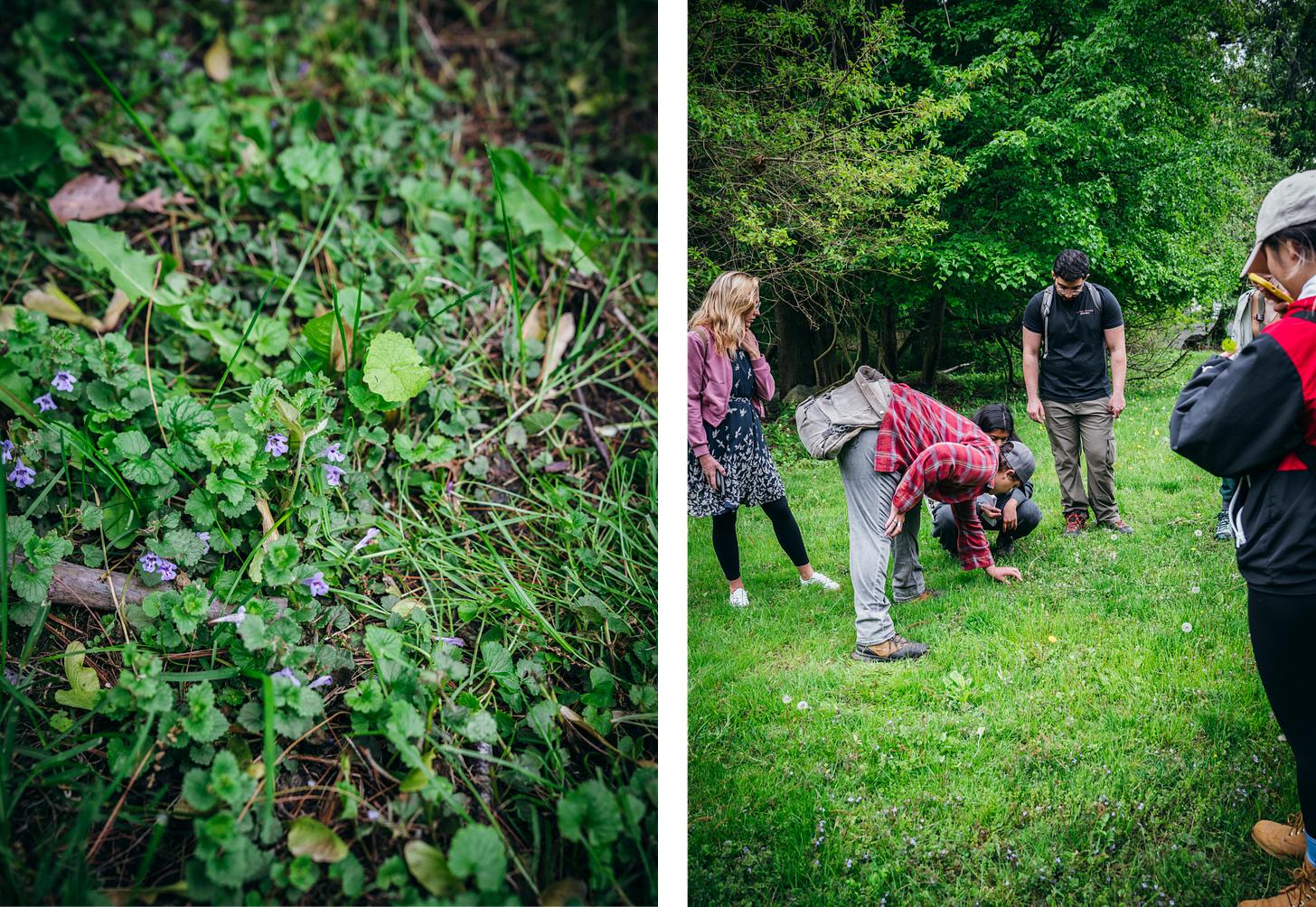




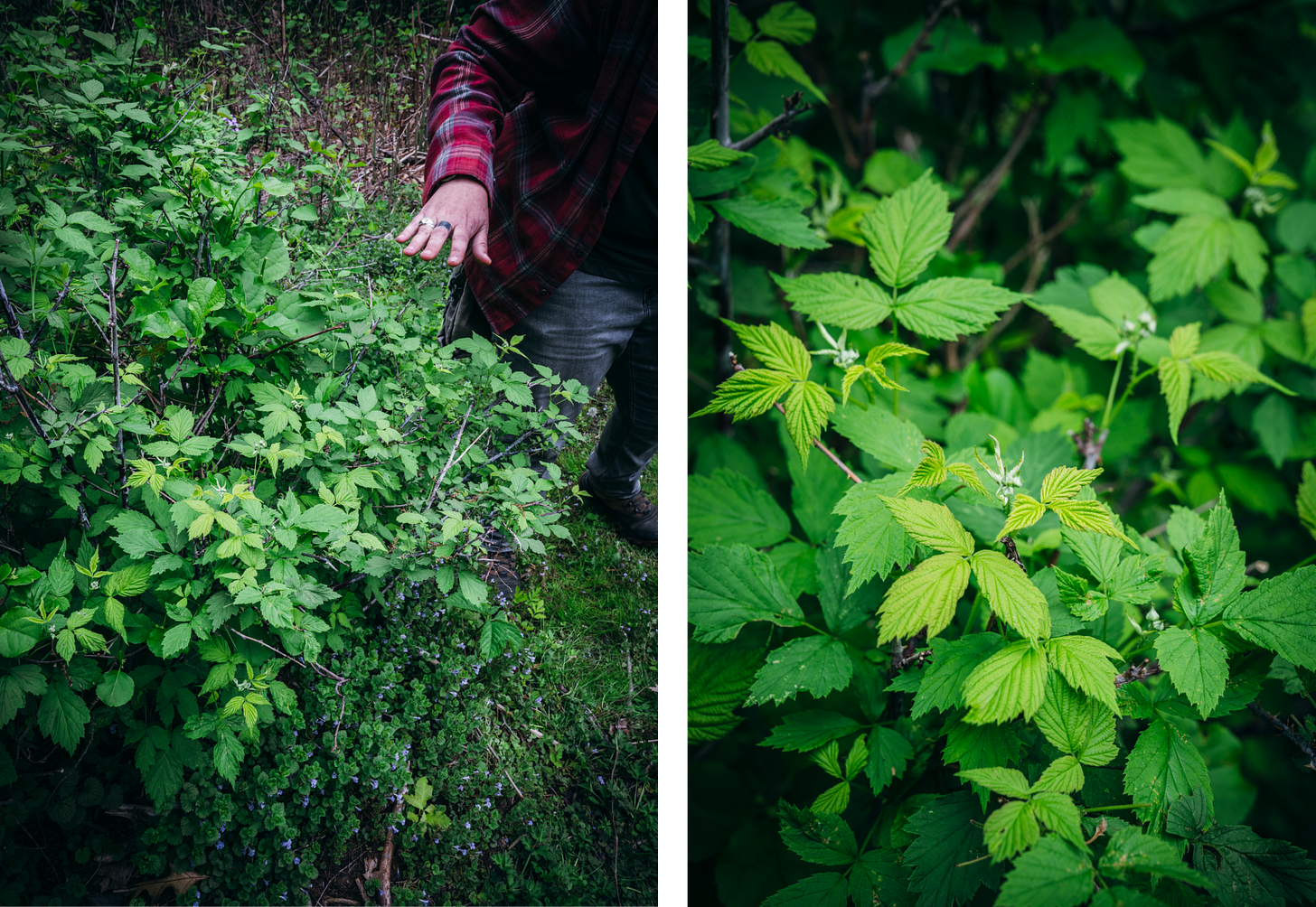



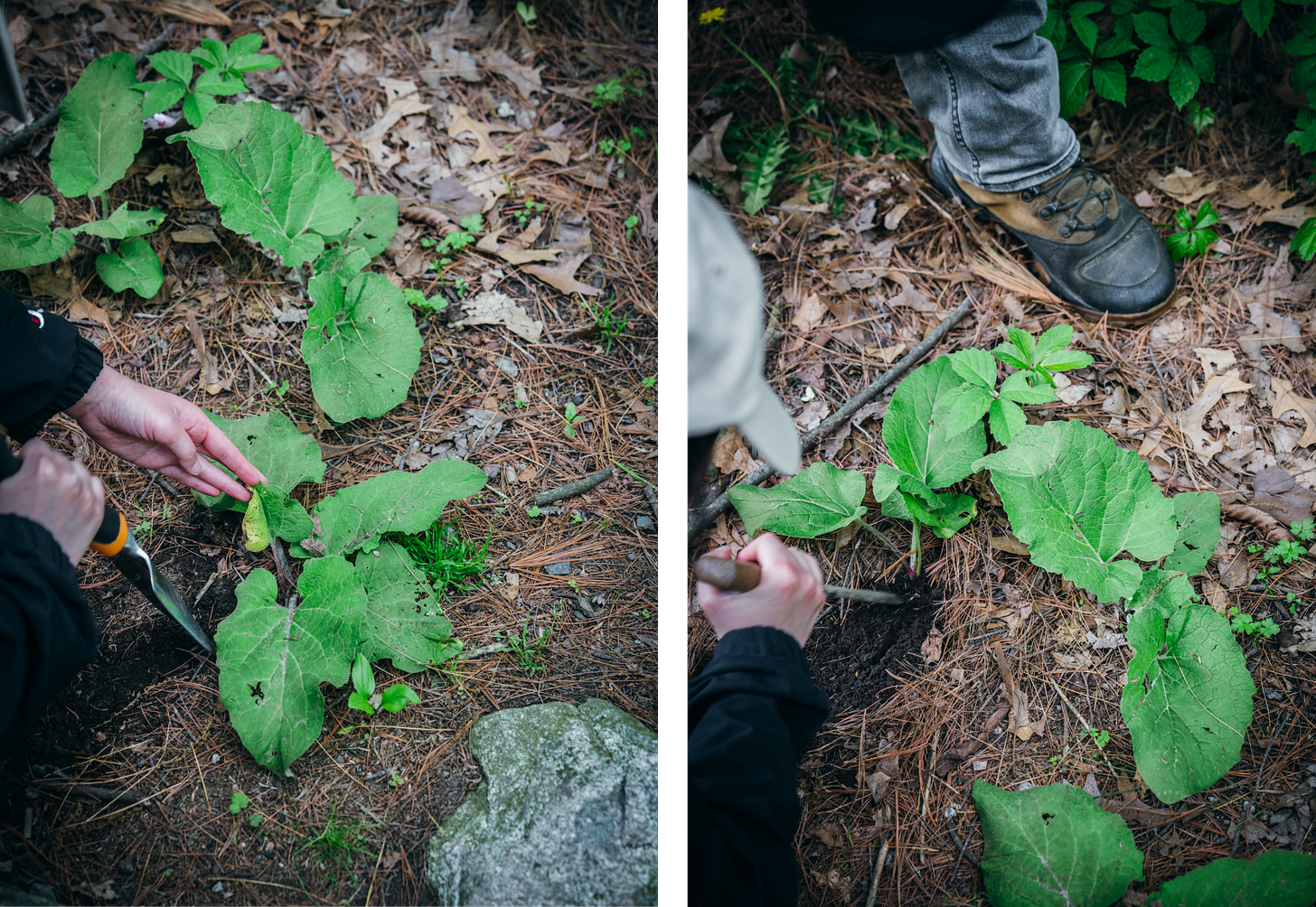

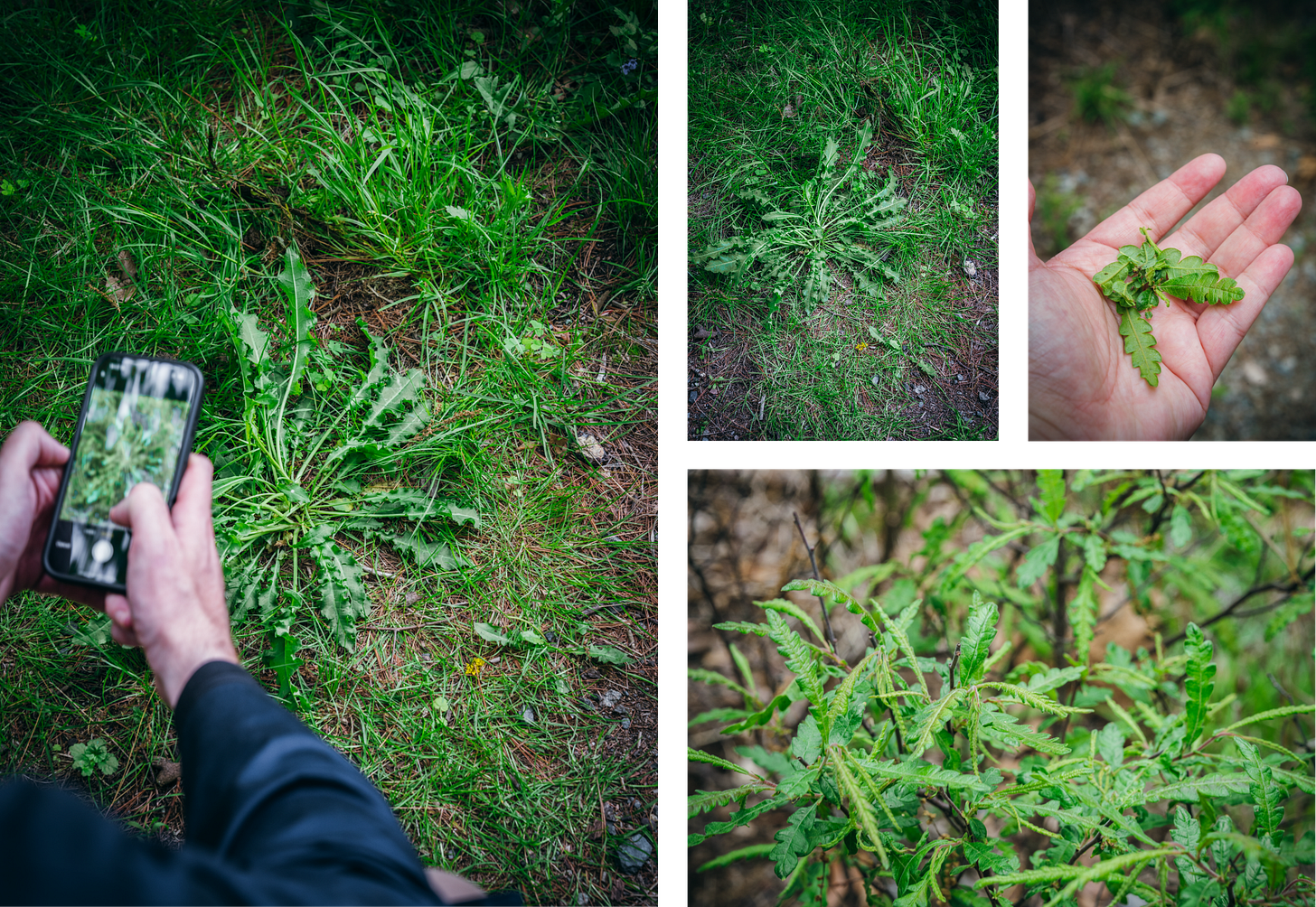






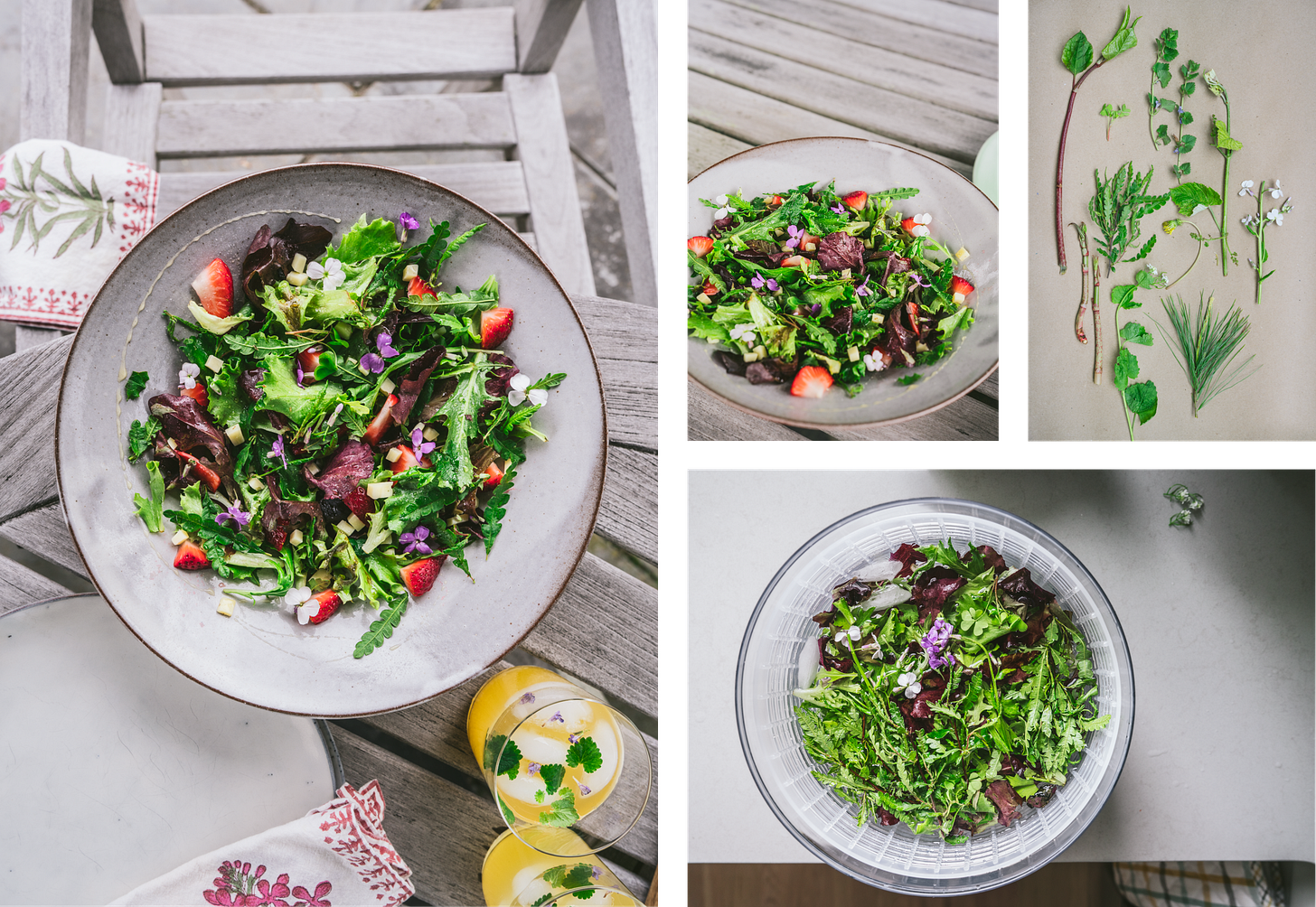


Love this, Eli!
Great post, Elisabet! Country living has many benefits, yeah? Thank you for the details on the wild plants and great photos. What a great meal you made. I didn't find garlic mustard where I live this year, but I want to make the knotweed with garlic mustard sauce next season.